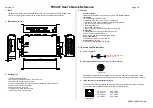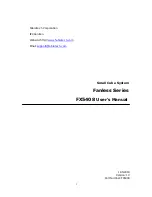
Installation and Operational Instructions for
EAS
®
-Compact
®
overload clutch,
Type 49_._ _4._ Sizes 4 and 5
(B.4.14.6.GB)
25/01/2013 GC/NH/GH/SU
Chr. Mayr GmbH + Co. KG
Tel.: +49 8341 804-0
Eichenstraße 1
Fax: +49 8341 804-421
D-87665 Mauerstetten
www.mayr.com
Page
20
of
21
Germany
E-Mail:
Malfunctions / Breakdowns Type 494._ _ 4.2 / Size 5 (continued)
Malfunction
Possible Causes
Solutions
Premature wear of
the elastomeric
element
Incorrect alignment
1)
Set the system out of operation
2)
Find / resolve the cause of incorrect alignment
(e.g. loose foundation screw, broken motor attachment,
warmth expansion of system components, changes in
coupling installation dimension "Z")
3)
Check the coupling for wear
4)
Insert new elastomeric element
e.g. contact with
aggressive fluids / oils,
ozone influence,
too high ambient temperatures, etc,
which cause physical changes in the
elastomeric element
1)
Set the system out of operation
2)
Dismantle the coupling and remove the remainders of the
elastomeric element
3)
Check the coupling parts and replace if damaged
4)
Insert new elastomeric element, mount the coupling parts
5)
Check the alignment and correct if necessary
6)
Make sure that further physical changes in the elastomeric
element can be excluded
The ambient or contact temperatures
permitted for the elastomeric element are
exceeded
1)
Set the system out of operation
2)
Dismantle the coupling and remove the remainders of the
elastomeric element
3)
Check the coupling parts and replace if damaged
4)
Insert new elastomeric element, mount the coupling parts
5)
Check the alignment and correct if necessary
6)
Check the ambient or contact temperature and regulate
them (possibly using other elastomeric element materials)
Premature wear of
the elastomeric
element (liquefied
material in the interior
of the elastomeric
element cams)
Drive vibrations
1)
Set the system out of operation
2)
Dismantle the coupling and remove the remainders of the
elastomeric element
3)
Check the coupling parts and replace if damaged
4)
Insert new elastomeric element, mount the coupling parts
5)
Check the alignment and correct if necessary
6)
Determine the cause of vibration (maybe the problem can
be resolved by using an elastomeric element with lower or
higher shore hardness)


































